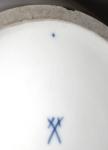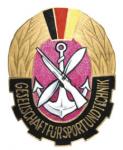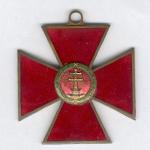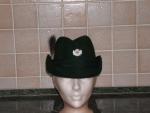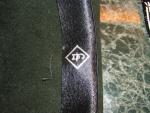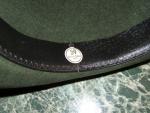-
Posts
4,807 -
Joined
-
Last visited
-
Days Won
12
Content Type
Profiles
Forums
Blogs
Gallery
Events
Store
Everything posted by Gordon Craig
-

DDR A GST Collectable
Gordon Craig replied to Gordon Craig's topic in Germany: Post 1945: Bundesrepublik & DDR
Grant, No to the price. It didn't sell and didn't appear in the next auction. Who really knows what things like this are worth? Regards, Gordon -
Richard S, It figures you would have a copy of that book. Can not be many of us who do. Charles and I refer to this book as "The Blue Bible". Regards, Gordon
-

DDR A GST Collectable
Gordon Craig replied to Gordon Craig's topic in Germany: Post 1945: Bundesrepublik & DDR
You will note that there is some enamle damage around the bottom on the vase. This would detract from the overall value of any piece but probably not a lot from this specific one because I doubt that there were many made since I have only seen this one. Regards, Gordon -

DDR A GST Collectable
Gordon Craig replied to Gordon Craig's topic in Germany: Post 1945: Bundesrepublik & DDR
-

DDR A GST Collectable
Gordon Craig replied to Gordon Craig's topic in Germany: Post 1945: Bundesrepublik & DDR
-

DDR A GST Collectable
Gordon Craig replied to Gordon Craig's topic in Germany: Post 1945: Bundesrepublik & DDR
-

DDR A GST Collectable
Gordon Craig replied to Gordon Craig's topic in Germany: Post 1945: Bundesrepublik & DDR
-

DDR A GST Collectable
Gordon Craig replied to Gordon Craig's topic in Germany: Post 1945: Bundesrepublik & DDR
-
Genst, This item was offered through a Berlin auction house last year. It is an interesting piece because of the subject and the excellent art work. At 10,000.00 Euros, it did not sell. Regards, Gordon
-

DDR My First Uniform: Please Take a Look!
Gordon Craig replied to Coinguy89's topic in Germany: Post 1945: Bundesrepublik & DDR
coinguy89, A nice Bereitschaft police uniform. It has the correct style collar tabs for an enlisted man and matches the shoulderboards well. Barracks police had a slightly different colour of green than that used by the VOPO. The best general uniform references are Keubke's books. His first one "Uniformen der Nationalen Volkesarmy der DDR 1956-1986" would be useful if you don't speak German because there is an English translation available for it. A copy of the unpdated volum of this book "Militarische Uniformen in der DDR 1949-1990" is useful because it covers the whole period of the DDR military uniforms including the early police and the DfD. The only hat book worth buying is Wilhelm Zoller's "Kopfbedeckungen militarisch uniformierter Organizationen in Europe - Detsche Demokratische Republik 1945-1990". The neweset book on the market, and this is a reprint, is pictures of the NVA and is useful for general reference for the everyday wear of the uniform. It is, 'Die Nationale Volkesarmee' from Siegler Verlag Gmbh. Regards, Gordon -
Gents, Does anyone recognize this cross? The reverse is plain only showing a rivet where the central piece is attached to the cross. The arms are 52mm (2 inches) across. Regards, Gordon
-

DDR East German Forestry Service Uniforms
Gordon Craig replied to Gordon Craig's topic in Germany: Post 1945: Bundesrepublik & DDR
Grant, Prices could indicate rarity but I don't know that for sure. I haven't actively hunted for these medals. At least not until now! Your comment has spiked my interest and I should have these medals to complete my collection of DDR Forestry items. There are a couple of variations as well that may be more difficult to get. I'll get some info from Berlin and let you know if they really are that expensive and rare. Regards, Gordon -

DDR East German Forestry Service Uniforms
Gordon Craig replied to Gordon Craig's topic in Germany: Post 1945: Bundesrepublik & DDR
-

DDR East German Forestry Service Uniforms
Gordon Craig replied to Gordon Craig's topic in Germany: Post 1945: Bundesrepublik & DDR
-

DDR East German Forestry Service Uniforms
Gordon Craig replied to Gordon Craig's topic in Germany: Post 1945: Bundesrepublik & DDR
Grant, It must be old age and my focus on uniforms that made me "momentarily" forget about the Forstwirtschaft medals. I was certainly aware of them in the past. The problem with the human brain is that, at least mine does, it stores things like a FIFO shift register IE first in first out. The more information I take in the more I forget! Anyway, back to the topic at hand. Here pictures and names of three specific awards for the DDR Forest Service. The photos are all taken from Deutsche Orden und Ehrenzeichen by Nummergut/Feder/von der Heyde. They prices listed are termed "actual market prices" but all books say that and the prices are rarely realistically what you would pay for an award. My rule of thumb is for a medal in mint condition I would take 60% of the listed value as the max I would pay. Probably less unless it were cased and then I fly by the seat of my pants. The years listed unde the awards indicate the year of introduction. Here we go with the awards. -

Hungary Hungarian Kivalo Dolgozol Badges
Gordon Craig replied to hunyadi's topic in Central & Eastern European States
Charles, Another great photo. I'll put it in my archives for the KISZ article I 'm working on. The woman at the front of the photo is a KISZ leader of a Joung Pioneer Group. You can see her girls in uniform behind her. She is wearing the standard KISZ leaders shirt and badge. I would really like one of those. The shirt not the girl. My wife would have something to say about that!! Regards, Gordon -

DDR East German Forestry Service Uniforms
Gordon Craig replied to Gordon Craig's topic in Germany: Post 1945: Bundesrepublik & DDR
Grant, Yes I have that site bookmarked. Thanks for reminding me of that medal. There are a few others as well. I hope that I will be able to find some time tomorrow to post pictures of them. Regards, Gordon -

DDR East German Forestry Service Uniforms
Gordon Craig replied to Gordon Craig's topic in Germany: Post 1945: Bundesrepublik & DDR
Grant, I don't even know if there are any specific medals for the DDR Forestry Service. Since it was a state organization they probably quailfied for the civil service type of long service awards but it is a question that has never come up before. I'll have to look into it. Since you almost never see pictures of DDR Forestry personnel in uniform I have no reference to look at. I'll see what I can find out. Regards, Gordon -

DDR East German Forestry Service Uniforms
Gordon Craig replied to Gordon Craig's topic in Germany: Post 1945: Bundesrepublik & DDR
-

DDR East German Forestry Service Uniforms
Gordon Craig replied to Gordon Craig's topic in Germany: Post 1945: Bundesrepublik & DDR
Next up is the Women's Forestry hat. I am not sure if this cap was called a "Hut" as well. They are so rare I have no information on them. It s construction is totally different from the man's Hut. The man's Hut is formed from one piece of felt. The woman's cap is made by sewing together nine pieces of felt. The brush is also on the opposite side from the men. It has a hat band of the same material trimmed with the same material as the brim. The man's hut does not. -

DDR East German Forestry Service Uniforms
Gordon Craig replied to Gordon Craig's topic in Germany: Post 1945: Bundesrepublik & DDR
-

DDR East German Forestry Service Uniforms
Gordon Craig replied to Gordon Craig's topic in Germany: Post 1945: Bundesrepublik & DDR
Next up is the makers lable. If you have problems reading the small lable it gives the size and the wording "Betrieb Gruben DDR". A well known cap maker in Germany.


